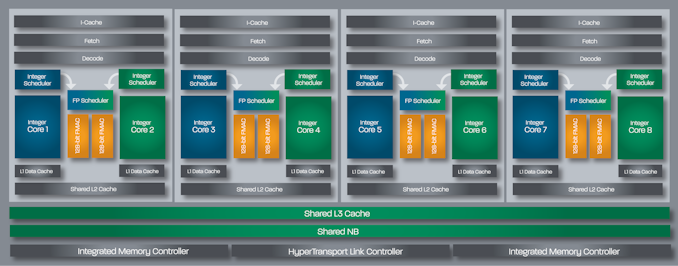AMD Bulldozer 'Core' Lawsuit: AMD Settles for $12.1m, Payouts for Some
by Anton Shilov on August 28, 2019 1:15 PM EST
AMD this month has agreed to pay compensation that totals $12.1 million to users who purchased FX-8000/9000 CPUs via its website or in the state of California. The case comes down to AMD advertising these processors as having 8 cores, and the claim that a shared FPU unit within a 'dual core' module does not constitute an actual core of performance similar to a separate core/FPU unit. Users who qualify for the compensation are estimated to recieve in the region on $35, depending on the exact uptake, and no one person can claim more than $7500.
AMD’s Bulldozer microarchitecture used 'dual-core modules' containing two independent ALUs and a shared FPU. AMD believed that such design allowed it to call its FX-8000 and FX-9000 series processors as the industry’s first eight-core desktop CPUs, yet the latter were quite often behind their quad-core rivals from Intel in terms of performance. As a result, a group of people from California filed a class action suit that accused AMD of false advertising back in 2015.
In early 2019, the Northern District Court of California sided with the plaintiffs and ruled that AMD’s FX-8120, FX-8150, FX-8320, FX-8350, FX-8370, FX-9370, and FX-9590 processors were incorrectly advertised as having eight cores. On August 23, the court published the class action settlement agreement under which AMD agreed to pay plaintiffs and the settlement class a compensation.
Under the terms of the deal, AMD has to create a $12.1 million settlement fund that will cover compensations to the end users, attorney fees, and settlement administration fees. The Class Counsel agreed to limit its petition for attorneys’ fees and reimbursement of expenses to no more than 30% of the fund, or $3.630 million, whereas the costs of settlement administration will be between $350,000 and $700,000. As a result, the pot to share between the actual purchasers of AMD’s select FX processors will be between $7.77 million and $8.12 million.
Purchasers entitled for up to $7500 total, have a confirmed purchase(s), and to have purched one of the processors while living in California or from AMD's website. It is noteworthy that people who bought AMD’s FX-8000E series CPUs with reduced power consumption are not eligible to get a reimbursement, and neither are people who purchased AMD’s six-core and quad-core FX-6000 and FX-4000 products.
It is hard to estimate how much money will each owner of AMD’s FX-8120, FX-8150, FX-8320, FX-8350, FX-8370, FX-9370, and FX-9590 processors will get, but considering the fact the settlement is limited to select CPUs and residents of California and those from AMD.com, actual sums may be quite sizeable. Should the actual value per unit be over $300, this will be subject to court approval.
AMD and the Settlement Administrator are order to crease a website at www.AMDCPUSettlement.com that should include the ability to file claim forms online. At press time, the website was offline, but it should be up shortly. We are awaiting AMD's official press release on the matter.
Update:
AMD has given an official comment on the result:
"AMD is pleased to have reached a settlement of this lawsuit. While we believe the allegations are without merit, we also believe that eliminating the distraction and settling the litigation is in our best interest."
Related Reading
- AMD's Steamroller Detailed: 3rd Generation Bulldozer Core
- The Bulldozer Review: AMD FX-8150 Tested
- The Bulldozer Aftermath: Delving Even Deeper
Sources: PACER, The Register (click through for document filing)











81 Comments
View All Comments
wumpus - Wednesday, August 28, 2019 - link
There's a formal definition for core? I've been into computer architecture since before Anand started this site and I've never heard one (I suspect ones exist that aren't specific to CPUs and that a Bulldozer would contain far more than 8 "cores").Any indication that the research for this case was done by the legal offices of IBM? Not that they have any issue with AMD or Bulldozer, just that the IBM-Power architecture seems to rely on IBM's definition of "core" for per core licensing and it is almost the opposite of AMD's definition.
A stupid decision all around (although it may match the law, no idea about that. The law is certainly often an ass).
DigitalFreak - Wednesday, August 28, 2019 - link
The layman expects 8 cores to mean 8 identical cores, not some slight of hand marketing BS.DigitalFreak - Wednesday, August 28, 2019 - link
You notice that Intel didn't call a Core i7 with Hyperthreading and "8 core" processor.Xyler94 - Wednesday, August 28, 2019 - link
I mean, the CPU did have 8 Integer execution "Cores", but only 4 Floatpoint execution cores, so each integer core has to share a floatpoint with another integer core. it's not like Hyperthreading/SMT, where each core could execute 2 threads, it was that each integer core had to share a floatpoint core with another, so how do you categorize that?AMD's marketing at the time called it 8 cores, but it was more like 4 cores in terms of performance. It was indeed a weird core... but it wasn't threads of SMT/Hyperthreading.
eek2121 - Thursday, August 29, 2019 - link
Definitively not the first time this has happened. Likely won't be the last.Techie2 - Thursday, August 29, 2019 - link
The siren chasers collect millions off of these bogus lawsuits which are only allowed in the U.S. judicial system. Anyone qualified to even discuss this subject would know full well what a CPU core is and what a math coprocessor is. If not see Intel 286 CPU for a clue.By filing a meritless lawsuit unscrupulous lawyers force the hand of companies who could rack up tens of millions in litigation costs and then be subjected to the technical ignorance of a jury with the mentality to pay a woman a million dollars for pouring hot coffee on her crotch in a moving vehicle. This outrageous behavior that only exists in the U.S. judicial system is named: Jackpot Justice where paid liars dupe a jury into believing that it's always someone else's fault and that any corporation with deep pockets should pay for any perceived injustice even when as in the AMD CPU core case there was none. If you can't understand what a CPU core is then you should educate yourself instead of filing frivolous lawsuits that make bottom feeders wealthy. The real injustice in this case is that AMD is raped out of $12 million by devious players manipulating the system for profit. If $35 makes you "whole" in judicial terms then you were never "damaged" in the first place by buying an AMD CPU - which is precisely the case.
0ldman79 - Tuesday, September 17, 2019 - link
Well said.Pinapple1977 - Wednesday, December 18, 2019 - link
You should research the McDonalds hot coffee lawsuit before you go using it as an example. That lawsuit was infact NOT frivolous, the media blasted her at McDonalds behest- which goes to show the power of media. The Molten lava branded as coffee could have killed her. She was hospitalized. Infact she and her family first asked that they reduce the temperature of their coffee- which was refused- and not kindly. The lawsuit was launched there after. And rightly so. Beware of media smear campaigns, her case is an example of it, and how successful it can be.What you are saying about the CPU lawsuit is true. McDonalds coffee lady - Bad example for your argument.
mickulty - Friday, August 30, 2019 - link
The thing is it was like 4 intel cores in 8-thread performance, but nothing at all like 4 intel cores in 4-thread performance outside of specifically 256-bit FP.Look back on it, the biggest issue IMO wouldn't be the FPU that people always focus on, but the front-end. The shared front-end on a module could only decode instructions for one core at a time (although it could switch every cycle). The thing that really messed it up for AMD though is their own marketing, trying to position the idea of "CMT" as some kind of equivalent to SMT and a bulldozer module as the equivalent of an SMT core.
Of course, having said all of this, at the end of the day if Bulldozer had had the same architecture, the same limitations and the cores had just been faster then I doubt anyone would have complained in the first place. Realistically the problem is that people saw "8 cores" and expected perhaps 2x an i5-750 in performance, not that people expected some specific hardware implementation.
Samus - Wednesday, August 28, 2019 - link
There's a huge difference between logical (virtual) cores and physical cores. Bulldozer still had physical cores. They were just weaker in IPC and greatly penalized with a pair of cores sharing a single floating point unit.Programs and operating systems still detected every core as a core, and they were silicon. So this is kind of a sketchy lawsuit and shows (unsurprisingly) people who purchased these CPU's - regardless of marketing - had virtually no understanding of what they were buying into.
If the expectation was to have superior performance to Intel, well, that's ridiculous. AMD hadn't been IPC competitive with Intel for nearly a decade prior to Zen and anybody telling you otherwise was either trolling you or a blind fanboy. Adding more cores with incredibly weak IPC and the added FPU penalty wasn't going to magically enhance the product.